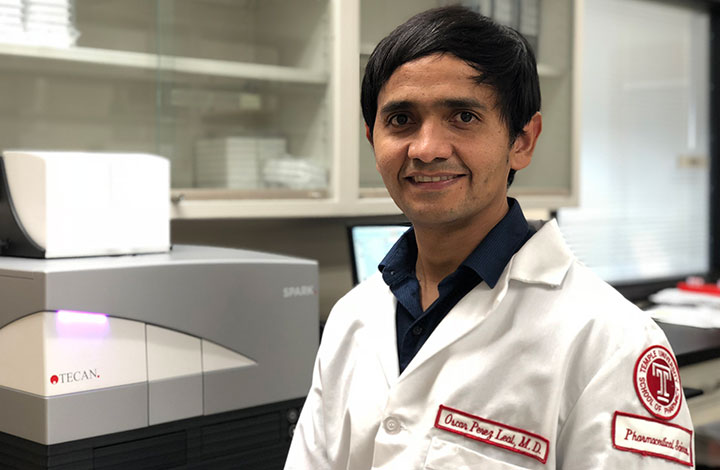The successful treatment of inflammatory diseases may lie with controlling the production of particular proteins, driving efforts to identify translational repressors for drug targeting. Scientists at the Moulder Center for Drug Discovery Research have developed luminescencebased biosensors for protein detection, supporting multiplex studies and timecourse assays for identifying and characterizing novel compounds.
The Moulder Center for Drug Discovery Research in Philadelphia, USA, serves as a multidisciplinary research hub for Temple University School of Pharmacy, one of the oldest schools in Pennsylvania. The center focuses its efforts on addiction withdrawal, Alzheimer’s disease, cancer, anti-viral agents, and cardiovascular and metabolic diseases. Dr Oscar Perez-Leal, an Assistant Professor, explained: “My research focuses on drug development for inflammatory diseases, in particular, fatty liver disease – which is increasingly prevalent due to obesity – and psoriasis, both of which have a high degree of inflammation and related oxidative stress. My primary interest is in identifying translational repressors of proteins that could become new drug targets. In the last few years, I have created luminescence-based biosensors – basically living cells that will only emit light when, for example, the target protein is being produced – and have a couple of related patents. Using these biosensors, I can identify compounds that activate certain antioxidant pathways, which may have therapeutic applications.”
Oscar continued: “The types of things we can now achieve in biological research are increasingly complex. There are many tools to investigate different properties of cells, and you can use one device to study multiple things simultaneously. For example, it is possible to carry out multiplex studies involving both luminescence and fluorescence, the latter being used to monitor cell viability. This approach provides much greater insight into how cells respond to drugs, but depends on having an instrument that also offers live cell incubation, as well as monochromators to allow selection of the appropriate wavelengths for excitation and emission. The Spark® multimode microplate reader – which was purchased in December 2017 – is well suited to meet these requirements.”

Dr Perez-Leal
“In order to evaluate the capabilities of the reader, I borrowed a system from Tecan for a week to test it out, supported by a company rep for the first three days. I did a fair amount of preparation in advance, so I could spend the week setting up assays, using the system as much as possible and learning how to operate it, as well as making comparisons with other instruments in terms of sensitivity and speed. I experimented with many of the Spark’s parameters that week, and I really liked the fact that I was able to use it and understand how it works fairly quickly. As a result, when the system was purchased, I already had some basic assay protocols set up, and have been able to get a lot of data in a short space of time.”
"It’s convenient to have a multifunctional platform to handle routine screenings, as well as more infrequent specialized applications, which generates high quality data every day of the week – it’s fantastic!"
“It’s not uncommon for labs to purchase an instrument for a particular project without thinking of the wider, long-term provision. They might only need a platform with luminescence capabilities, and then discover further down the line that they would have liked live cell incubation as well. I wanted to combine everything I might need in a single platform, allowing me to run lots of different assays, which I simply couldn’t do previously. For example, developing live cell systems involves DNA manipulation and molecular biology, so quantifying DNA and protein concentrations using the NanoQuant Plate™ is ideal. It’s convenient to have a multifunctional platform to handle routine screenings, as well as more infrequent specialized applications, which generates high quality data every day of the week – it’s fantastic!”
“The control module is intuitive and easy to use, and it’s straightforward to select the steps you need. The software arranges them sequentially so I can see the overall workflow from top to bottom. One of the great benefits of the Spark is being able to identify compounds with interesting functionality – say at the 12- or 24-hour time point – and then isolate them to run time-course assays using different concentrations, which offer a wealth of information.
For example, I can determine when a compound reaches maximum activity or the lowest concentration that shows a therapeutic effect, and it’s great to be able to observe all of this in real time. It makes such a difference being able to leave the plate in the reader and not have to transfer it backwards and forwards to an incubator. Before the Spark, I simply didn’t have this functionality in the lab; it was impossible to do this with my previous set-up. I’m very satisfied with the instrument, and I’ve enjoyed working with the Tecan team – they’ve been very supportive,” Oscar concluded.
To find out more about Tecan’s Spark reader, visit www.tecan.com/spark
To learn more about the Moulder Center for Drug Discovery Research, go to moulder.temple.edu
Keywords:









